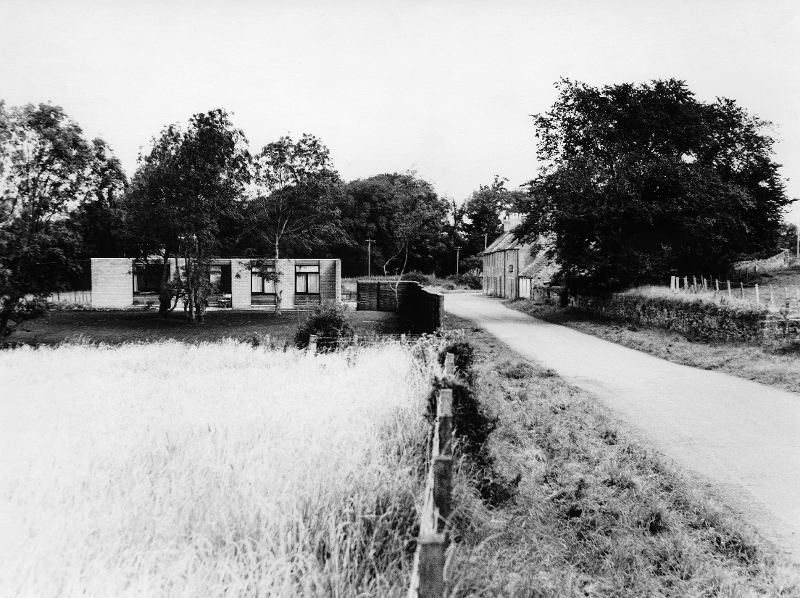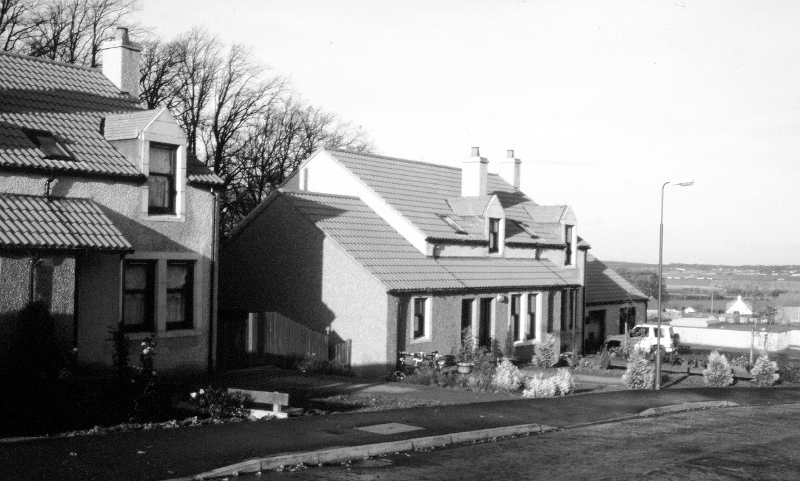Almost all of the homes in the parish are owner-occupied, with the exception of properties in the area owned by the Fletcher estate or Hamilton Farming Enterprises, which are either occupied by those who work on the land or rented out.

West Saltoun, c1970
East Saltoun is the main settlement in the parish. West Saltoun, one mile west, consists of one street of 15 houses. The only pressure for development is for new housing on a relatively small scale, mainly in the village of East Saltoun. More housing has meant a small reduction in farmland and more hard landscaping.
There has been little change in the location of housing since 1945. Council houses were built in East Saltoun throughout the 1940s, 1950s and 1960s, most in West Crescent; many of these have been sold, sometimes but not always to existing tenants. The council still owns a few pensioners’ cottages.
Both Margaret McCormack and Jeannie Sandilands moved with their parents to West Crescent in the late 1940s – early 1950s as the farm cottages on Main Street were considered unfit for habitation.
Living conditions in the late 1940s and 1950s were simple. There were many large families, often crammed into a small house. The living room would have linoleum on the floor with the occasional rag rug, the backing of which was easily come by. There would be a range or open fire with usually a kettle or a pot of soup quietly simmering. Fuel would mainly be wood, easily come by as there was a local sawmill, and coal. A primus stove would often by kept for emergencies.
These were the days prior to washing machines and often the washing would be laundered with a washboard over an open fire outside. Flat irons were still being used but were gradually being replaced by electric ones. Most food was home produced. Country gardens would hold vegetables and fruit, hens were kept – there is an old photograph in evidence showing hens grazing where the new churchyard extension is now.
Milk would be collected from the farm. The Co-op vans came round regularly, often taking your order and returning within a day or two with it.
Margaret McCormack
The row of stone cottages on the main street was renovated in 1960/70s forming three houses.
The ruined cottage, The Lang Hoose, was restored in the 1950s (Scots Magazine, April 1975).
A house was built at the back of East Saltoun garage, and six on the Upper Saltoun/Petersmuir road in East Saltoun. Three individual houses (Byre Court) were built behind the Tithe Byre in 1991.
The Glebe estate (mainly occupied by young families) in East Saltoun was built around 1990, with 20 houses owned by the Scottish Special Housing Association (ten fully, ten partly, plus three workshops). Despite much local protest, standard building templates were used. Four new houses were built in West Saltoun in the 1960s and 1970s; here too, the row of terraced houses was extended in 1970s. The Fletcher Dower House at West Saltoun was turned into two flats.
There is less need now for housing for farm workers, and some of the cottages, including the Saltoun Hall lodge cottages, the gardener’s cottage and the kennels cottages in West Saltoun are privately rented. Other rented properties include the Home Farm and Middlemains with a number of cottages, and Greenhead Farm and cottages.
One house was built beside the old walled garden at Saltoun Hall. Saltoun Hall itself was converted into flats (see Townscapes, Buildings & Landscapes of Distinction) and the former stable block there was converted into a private dwelling called Saltoun House in the 1970s. The former gas works for Saltoun Hall was converted into a private house in the 1970s.

Housing in East Saltoun
There has been only one steading conversion in the parish, at Upper Townhead, which was converted into two houses in the early 1980s and one other in 1995. A bungalow was built beside Greenhead farm steading and also two cottages.
The Old Castle or Castle o’ Cloots in East Saltoun, built in the 18th century – perhaps earlier – was restored in 1979-81. The restoration won awards from the Saltire Society and the Association for the Protection of Rural Scotland (Hedderwick, R. (1987) Vol XIX).
The Barley Mill in West Saltoun, built in 1712, was kept wind and watertight after being no longer required as a mill, but fell into disrepair in the 1950s; it was converted into a private house in the 1970/80s. The brownfield site at Middlemains (the old lime kiln site) was converted in 1985, creating two houses within the lime barn and a new house built on the site of the workers’ cottages. Two new houses were built at Spilmersford Bridge, and a further two were built in the 1960s and 1970s close to East Saltoun Plantation in Lower Saltoun.
Typically for a rural parish, for many years homes in Saltoun relied mainly on open fires burning wood and coal. The weekly bath was common for many years; as in other parts of the county only the advent of electricity, and therefore easier hot water, and much later, showers, gave people easier access to more frequent bathing.
Farm workers wore clothing suitable for the job and in the years after the war this was often ex-Army clothing. Women, including female teachers, did not start wearing trousers until the 1970s, and even then only the younger and more adventurous ones.
The advent of the washing machine was a boon for the wives of agricultural workers who would labour over the washing of farm overalls, boiler suits and later on, jeans.
Utilities
The parish is served by the public water supply, with the water drawn from three different sources – Hopes (the biggest), Stobshiel and Fountainhall.
The main sewer from East Saltoun drains to processing tanks near Saltoun Home Farm. There are septic tanks attached to houses outwith the settlements; the council was responsible for emptying these until the 1990s. This is now the responsibility of East of Scotland Water, which charges occupants for clearing tanks.
At the beginning of this period some houses were still without mains electricity, but with a few exceptions, these were predominately outwith the settlements.
Mains gas is not available anywhere in the parish. A few residents use LPG.
Television came to the parish in 1953. Reception is reasonable, although Channel 5 is not generally available. Satellite TV is available through individual dishes, but there is no cable television.
There are no mobile phone masts in the parish. The service received is patchy. Some mobile phone operators provide reasonable reception, but the parish is on the black list for poor reception for several companies.
The main streets in East and West Saltoun are lit, but there is no street lighting outwith the settlements.
The council has a weekly general rubbish collection throughout the parish, but no collection of paper, glass or garden waste. Special collections can be arranged for larger items, but have to be paid for.
Shops & Services
The only shop in the parish in 2000 is the post office in East Saltoun. There was also a small
general store until the early 1990s, and thereafter some basic items were sold in the garage until it closed in 2001. West Saltoun had a small general store until the early 1970s.
Within the village, a range of services is now available. These include: childcare; building; plumbing; garage; post office; kennels and cattery; dry cleaning through the post office; blacksmith and farrier; garden tools maintenance; domestic help; gardening; play areas; public phone. East Saltoun’s garage provided both fuel and vehicle repairs to the end of the period, but closed in 2001.
The old inn (uphill, adjacent to the manse wall) in the village was gone by the end of the war, and replaced by council housing; Swinton had owned it.
In the early part of this period, Co-op vans carried a wide range of items, and would take orders to supply specific items on request. They were the lifeline to communities and villages and settlements. In 1945 nearly 100 vans were on East Lothian roads. These vans were discontinued in early 1990s.
Clothing would often be purchased from Co-op vans, which would bring a selection out from the shop to the village. Otherwise people travelled to Tranent or Haddington to the Co-op stores, and perhaps to Edinburgh for something special. Haddington had a wider selection of ’boutique’ type shops for the more fashion-conscious from the 1960s and 1970s onwards.
Travelling vans run by private businesses still supply fish, green groceries and milk. Recently, regular deliveries of boxes of organic fruit and vegetables have been introduced on request.

Post Office, East Saltoun
By 2000, the number of mobile services had been drastically reduced. A mobile bank operated until the 1990s, and the council’s mobile library still visits regularly. A hairdresser provides a service for people in their own homes.